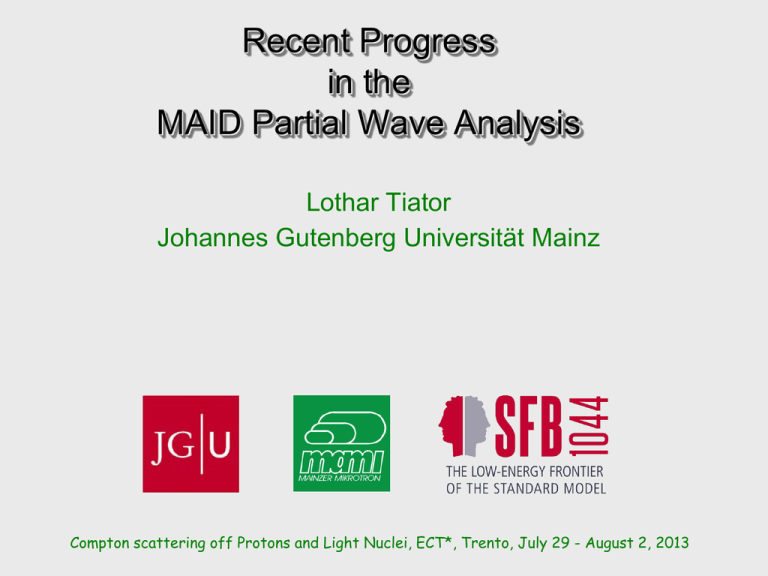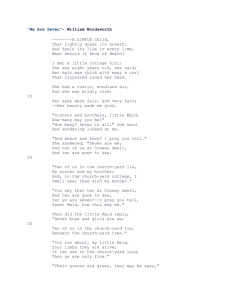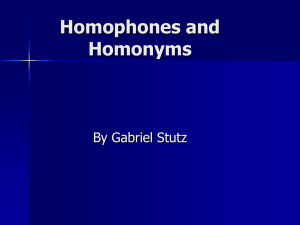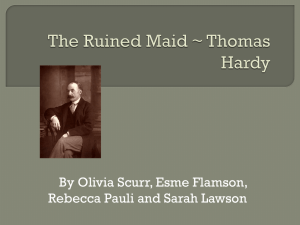Recent Progress in the MAID Partial Wave Analysis
advertisement

Recent Progress in the MAID Partial Wave Analysis Lothar Tiator Johannes Gutenberg Universität Mainz Compton scattering off Protons and Light Nuclei, ECT*, Trento, July 29 - August 2, 2013 a dispersive view of Compton scattering Born pole terms single-meson production double-meson production current MAID projects our motivation precise knowledge of meson photoproduction amplitudes is important for: • • • • • designing of proposals, setting up experiments and data analysis comparison with EFT, near threshold and near resonances dispersion theoretical applications, as Compton scattering, 2g processes, various sum rules many applications by Barbara Pasquini (RCS,VCS,SSA,FFR) baryon resonance analysis, besides pN -> pN, gN->pN is the most important source comparisons with quark models and lattice QCD, especially for N* physics PWA groups, also doing g,N SAID 2006/2012 model indep. single ch. PWA pN->pN, pN->hN, gN->pN, gN->hN http://gwdac.phys.gwu.edu/ BnGa 2012 multichannel partial wave analysis, pN, hN, ppN, KL, KS, gN http://pwa.hiskp.uni-bonn.de/ MAID 2007 unitary isobar model, single ch. gN->pN, gN->hN, gN->KL(S) http://www.kph.uni-mainz.de/MAID/ DMT 2007 dynamical model with few coupled channels, pN, hN, ppN, gN http://www.kph.uni-mainz.de/MAID/ Jülich 2012 dynamical model with coupled ch., pN, hN, ppN, KL, KS, ..., gN Gießen 2012 coupled ch. unitary Lagrangian model, pN, hN, ppN, KL, KS, gN Kent State 2013 K matrix coupled channels, pN, hN, ppN, KL, KS, gN ANL-Osaka 2013 dynamical model with coupled ch., pN, hN, ppN, KL, KS, ..., gN nucleon response to real and virtual photons Threshold Region Resonance Region helicity difference Ds = s3/2 – s1/2 for the proton D. Drechsel and L. Tiator, Ann. Rev. Nucl. Part. Sci. 2004, 54:69-114 forward Spin polarizability and GDH sumrule forward spin polarizability GDH Coll. (MAMI & ELSA) Ahrens et al., PRL87 (2001) Dutz et al. PRL91 (2003) GDH sum rule GDH Coll. (MAMI & ELSA, 200-2005) + MAID + Regge MAID 2013 status of 28 N resonances red : 4-star blue : new, upgraded or renamed g,h g,K g,K g,K J/Y g,K mainly from kaon photoproduction g,K J/Y from BES-III 2013 status of 22 D resonances no changes no new states but many uncertain states with less than 3-stars spin degrees of freedom: 4 for real, 6 for virtual photons virt 4 (6) invariant amplitudes (e.g. from EFT and Lagrangian models): 4 (6) CGLN amplitudes in cm frame (e.g. from isobar models): 4 (6) * Lmax partial wave amplitudes (multipoles) in cm frame: observables for real and virtual photons 16 (36) observables (cross sections and polarization observables): 2 (4) total (inclusive) cross sections: various sum rules for real and virtual photons: : Baldin : GDH : FSP SE and ED partial wave analysis ta(w) SE : single-energy analysis ED : energy-dependent analysis intelligent parametrization using symmetries, thresholds, branch points, poles, unitarity, dispersion relations, ... closer to the exp. data, no constraints in ideal case problem: multiple solutions very likely in practise: often losely bound to ED solutions, e.g. usual chisquared penalty term and do not have the same statistics as the underlying real data result of single-energy and energy-dependent fitting most observables that were fitted are in good agreement with MAID2007 reduced c2 from Maid07 fits to g,p data in different energy regions single-energy (SE) fits energy-dependent (ED) fits but with higher energies the analysis becomes more difficult and less accurate unitarity cusp at eta threshold J. Ahrens et al., (GDH and A-2 Collaboration), Phys. Rev. C 74, 045204 (2006) unpolarized total cross section polarized total cross section (helicity asymmetry) helicity separated cross sections comparison between MAID and SAID comparison between MAID and SAID Roper P11(1710) comparison of multipoles: MAID – SAID - BNGA from Anisovich et al., Eur. Phys. J. A. 44, 203-220 (2010) real parts of g,p0 multipoles Re Re Re Re no problems for M1+ surprisingly large differences, even though the world data is equally well described due to an incomplete data base 16 spin observables in photoproduction linear and circular polarized beams longitudinal and transverse polarized targets recoil polarization, in particular for KL and KS 8 observ. 12 observ. from M. Ostrick, NSTAR2013 (Mainz data): g p -> p p0 new prel. Mainz data with transversely polarized target MAID SAID BnGa preliminary MAMI data: T : target asymmetry F : lin. pol. photon beam – transv. target pol. new Bonn data with transversely polarized target new Bonn data with longitudinally polarized target how can we improve MAID ? main question: are the discrepancies due to background or resonance contributions? for background: we could add polynominal functions for resonance: we could add more Breit-Wigner terms PDG lists 50 resonances, MAID uses only 13 **** resonances our new strategy: obtain fits of partial waves to SE analysis then go back to observables perform a new SE-fit starting from new solution obtain a new fit of partial waves to new SE-fit continue this iteration until it converges Nucleon Resonance Analysis with Pietarinen expansion in collaboration with: Svarc (Zagreb), Osmanovic et al (Tuzla), Workman (GWU), arXiv:1307.4613 [hep-ph] The singularities that strongly influence the partial wave amplitudes in the physical region are the thresholds (branch-points) on the real axis and the poles in the closest (2nd) Riemann sheet: poles and branch points (regions) in the Jülich coupled channels model: 0 -50 -100 Im ECM [MeV] D3/2+ N3/2- N1/2+ N1/2- Nucleon Resonance Analysis with Pietarinen expansion in collaboration with: Svarc (Zagreb), Osmanovic et al (Tuzla), Workman (GWU), arXiv:1307.4613 [hep-ph] The singularities that strongly influence the partial wave amplitudes in the physical region are the thresholds (branch-points) on the real axis and the poles in the closest (2nd) Riemann sheet: poles and real and complex branch points in the Jülich coupled channels model: real branch point complex branch point pole Nucleon Resonance Analysis with Pietarinen expansion in collaboration with Svarc (Zagreb), Osmanovic et al (Tuzla), Workman (GWU), arXiv:1307.4613 [hep-ph] The L+P (Laurent+Pietarinen) expansion method is defined as: 1 Pietarinen series for each branch point we have typically 3 Pietarinens 1 in unphysical region E<thresh 2 in physical region, e.g. pN, ppN, hN thresholds the Pietarinen expansion is a conformal mapping of the w-plane onto the interior of the unit circle of the Z-plane E. Pietarinen, Nuovo Cim. Soc. Ital. Fis. 12A, 522 (1972) (successfully applied in the Karlsruhe pN partial wave analysis) Pietarinen expansion for the DMT pN PWA here we perform an L+P fit to the energy dependent DMT solution (arbitrary error band of ~5% assigned) pole positions and residues DMT model compared to the fit all poles, which are not too deep in the complex region are very well recovered. Pietarinen expansion for GWU/SAID SE(pN ) PWA resonance poles found in the L+P expansion: P1 = 1362 - i 89.5 P2 = 1716 - i 49.5 P3 = 1999 - i 71.5 the L+P expansion can discover resonance poles in the SE analysis, that did not exist in the ED solution the L+P expansion resembles very much the old Höhler analysis KH80 Pietarinen expansion for the MAID g,p PWA MAID energy-dependent solution (ED) for ED solutions, L+P expansion gives a numerical approximation ~ 10-3 MAID single-energy solution (SE) for SE solutions, L+P expansion gives the best-fit with a statistically significant c2 ~ 1 Pietarinen expansion for the MAID g,p PWA MAID energy-dependent solution (ED) P11(1710) is not included in MAID but it is found in the L+P expansion of the MAID single-energy analysis c2 compared for MAID2007 and new L+P expansion MAID2007 new L+P expansion method some improvement is visible, but the new solution fails for some observables, which are not fitted this method has less predictive power than the original unitary isobar model, however, it is perhaps a good method to solve the Complete Experiment the work is in progress new L+P fit to new polarization data from Mainz and Bonn new L+P fit MAID2007 SAID-SN11 for E < 900 MeV the fit looks reasonable, with G observable we are not yet satisfied new L+P fit to new polarization data from Mainz and Bonn new L+P fit MAID2007 SAID-SN11 for higher energies, E > 900 MeV the fits are not so good summary and conclusion • • • MAID has been very successfull over the last 15 years it has been used for many experimental proposals and also as a Partial Wave Analysis for photo- and electroproduction now, new polarization data show large discrepancies, which are due to N* and D resonances, which are not yet included and nontrivial background beyond Born terms and vector mesons both can be parametrized in a Laurent+Pietarinen (L+P) expansion, that will hopefully lead in a new improved MAID model this work is still in progress








